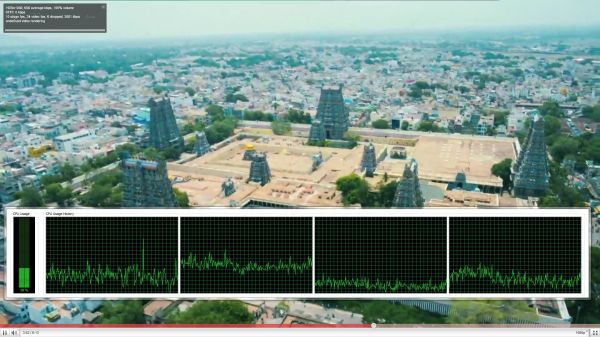Dell Zino HD 410 HTPC Review
by Ganesh T S on February 19, 2011 7:08 AM EST- Posted in
- HTPC
- Dell
- AMD
- Media Streamer
- ATI
The Zino 410 is covered quite nicely with respect to networking hardware. With support for both Gigabit Ethernet and 802.11n, it really doesn't matter if you keep the unit beyond cable reach from the router. All our network streaming tests were carried out with a 300 Mbps 802.11n network (currently provided in my lab location by a RT-N16 802.11n gigabit router from Asus). We were easily able to stream HD clips of more than 50 Mbps. HD YouTube videos and HD Netflix streaming had no issues.
While on the topic of network streaming, let us take a brief look at how the system performs while accessing online video services. We used Flash 10.1 in Firefox 3.6 with ATI Catalyst 11.1 for testing.
The first set of screenshots below show the CPU usage while playing back a 1080p YouTube video with and without hardware acceleration enabled. This is the same clip as the one used in the Core 100 and Vision 3D reviews. As can be seen, the GPU indeed supports Flash acceleration. However, the difference between the hardware accelerated and non-hardware accelerated CPU usage is around 11% only (39% for no hardware acceleration and 28% for hardware acceleration). We expect similar results for videos on Hulu.
1080p YouTube HD Streaming without Hardware Acceleration

1080p YouTube HD Streaming with Hardware Acceleration
Netflix streaming, on the other hand, uses Microsoft's Silverlight technology. Unlike Flash, hardware acceleration for the video decode process is not controlled by the user. It is upto the server side code to attempt GPU acceleration. Thankfully, Netflix does try to take advantage of the GPU's capabilities. This is evident from the A/V stats recorded while streaming a Netflix HD video at the maximum possible bitrate of 3.8 Mbps. While the video is definitely not 1080p, we observe that the CPU utilization of around 40% is higher than the CPU usage for a 1080p YouTube video.

Netflix HD Streaming with Hardware Acceleration
We suspect that the handling of the DRM in the case of Netflix streaming is done by the CPU, resulting in the higher usage.
Users of media streamers streaming online videos often have to put up with messages of the sort 'This content is not available on TV connected devices' or need to queue up the videos on a PC before accessing them through their media streamer box. HTPC users don't need to worry about any such limitations. For online media consumption, the Zino 410 is as good as the Core 100, but not as efficient as the Vision 3D.











69 Comments
View All Comments
silverblue - Saturday, February 19, 2011 - link
...would having two differently-sized SO-DIMMs have on system performance?I'd be tempted to take replace that 4GB module with a 2GB one just to see what happens. 6GB of RAM just doesn't compute. :)
We seem to be getting a decent number of Dell-AMD systems lately... I only hope they take up Brazos with the same level of enthusiasm, because even if it did result in a small drop in performance, this review would've been largely the same in terms of gaming and video playback/quality, albeit with a much smaller footprint. Also, in that scenario, dual channel wouldn't matter as Fusion doesn't support it.
fabarati - Saturday, February 19, 2011 - link
If AMD has anything like Intels asynchronous dual channel, the first 4 GB will perform like dual channel, whilst the remaining 2 GB will perform like single channel.Taft12 - Saturday, February 19, 2011 - link
Dual-channel memory was a scam from the beginning that has somehow survived to this day to make PC buyers think they needed to buy more memory than needed.Have you seen the benchmarks? ~1-2% benefit AT MOST for anything that's not a synthetic memory bandwidth test, regardless of platform.
http://www.tomshardware.com/reviews/PARALLEL-PROCE...
fabarati - Saturday, February 19, 2011 - link
Didn't it help back in the P4 and/or P-M days? And how did it do in early Athlon 64 days?But yeah, Core Duo and newer doesn't really benefit from Dual channel, one
silverblue - Saturday, February 19, 2011 - link
Theoretically, dual channel would help APUs as they're bandwidth-limited.I suppose you're right about standard usage though, even raising memory clocks doesn't make for a sizeable performance advantage.
asmoma - Saturday, February 19, 2011 - link
Starcraft 2 is not a synthetic memory test, and it does benefit from going from 2 to three channels, just read some performance reviews of Starcraft 2.DanNeely - Saturday, February 19, 2011 - link
The einstien@home applications benefitted from a 3rd channel on i7 quad cores; and the 2nd channel on C2 quads as well; high performance server farms/clusters/super computers are a significant segment of the market. On the i7-quad, E@H had a 66% speedup from the 2nd channel, and a 5% gain from the 3rd. Sandybridge gave a similar speedup from the 2nd channel. I can't find the thread with the C2Quad results, but IIRC they were a 10-25% speedup.http://einstein.phys.uwm.edu/forum_thread.php?id=8...
I don't have benchmarks handy, but I suspect a heavily loaded DB server would also benefit from the extra memory bandwidth because the queries would result in a psudorandom memory access pattern that would limit the ability of the cache controller to prefetch most of the data being requested.
jeremyshaw - Friday, March 4, 2011 - link
that actually had to do with uncore clocks, not memory channels.vailr - Saturday, February 19, 2011 - link
How would a Mac Mini compare?Could a Mac Mini be retrofitted with a Blu-Ray drive (since Blu-Ray is available factory installed) and then run as a Windows HTPC?
tipoo - Saturday, February 19, 2011 - link
Why on earth would you buy a Mini to run as a Windows HTPC? You'd pay more for less performance.